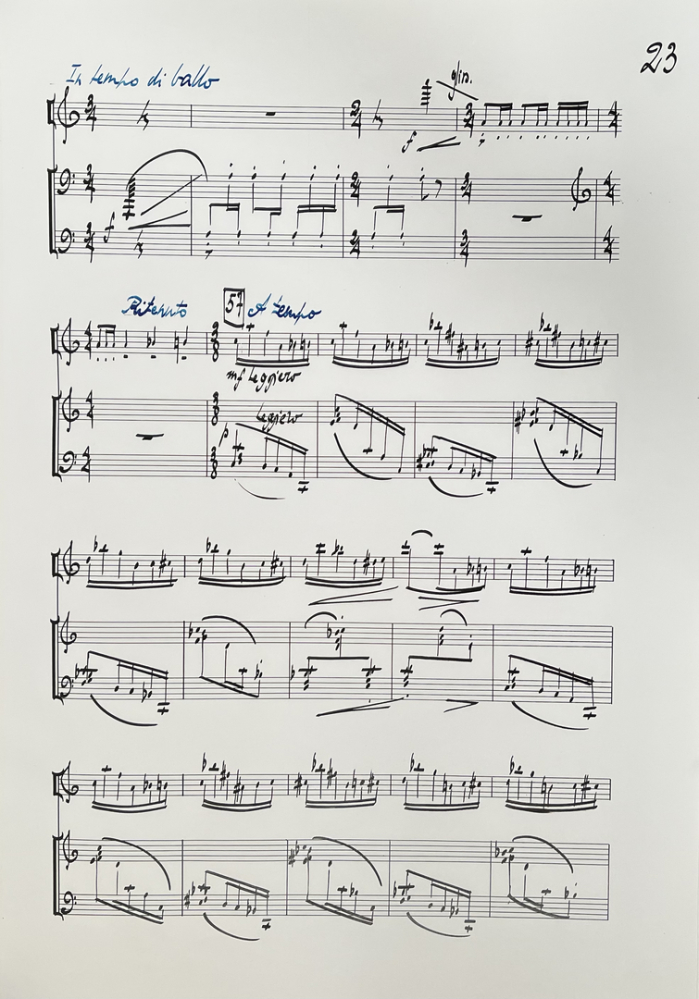
Sonate pour violon et piano
Title, Duration, Place, Year, Publisher, Dedicated to, Premiere (performer(s), place, date)
SONATE POUR VIOLON ET PIANO, 17', Bayonne/Chatou, 2000, Leduc, à Marion Delorme, Marion Delorme, violin, Naji Hakim, piano, American Church in Paris, 09.12.01
L'Allegro vivace initial, de style naïf, léger et fantasque, est bâti sur
le Branle de l'Official de Thoinot Arbeau. Ce thème est plus connu dans la tradition anglo-saxonne sous son adaptation en Noël, Ding dong merrily on high. Les
variations thématiques s'organisent sous une forme-lied avec coda. À partir du registre grave du violon, le mouvement central, Andante sostenuto, développe un
chant tendre et mélancolique, accompagné au piano par des grappes harmoniques denses articulées en rythme amphibraque. Un épisode central, plus léger et gracieux, paraphrase librement un Noël
alsacien, O Tannenbaum, d'où est tiré le motif générateur du mouvement. La réexposition s'enchaîne à une coda particulièrement expressive, Affettuoso, accompagnée d'une
longue pédale harmonique ; l'appoggiature du motif générateur est répétée en marche ascendante jusqu'à l'extrême aigu des instruments, à la recherche d'une ouverture vers l'éternel, annonçant le
dernier vers du thème principal du finale : ich bin im Himmel schoo ! (je suis déjà au Ciel !). Le dernier volet, In tempo di ballo, est un
brillant rondo-sonate plurithématique à variations, rappelant le caractère rythmique et joyeux du premier mouvement. Son thème principal, en perpetuum mobile de doubles croches,
s'inspire d'une chanson montagnarde de Colmar, Uff em Berjel, bin ich g'sässe (Quand je suis à la montagne). L'un des épisodes cite une Danse de Champagne de
Claude Gervaise. Naji Hakim a arrangé également Trois Noëls pour chœur a cappella, avec violon solo ad libitum (éditions U.M.P.,
Londres), à partir des principaux thèmes de cette Sonate.
The opening Allegro vivace, naive in style, light and fantastical, is based on the Branle de l'Official by
Thoinot Arbeau. This tune is better known in the English-speaking world as the Christmas carol Ding dong merrily on high. The thematic variations are organised in lied form with a
coda. From the low register of the violin the middle movement, Andante sostenuto, develops a gentle, melancholic theme, accompanied on the piano by dense clusters of harmony in
amphibrach rhythm. A central section, lighter and more graceful, is a free paraphrase of an Alsatian carol O Tannenbaum, which also provides the generative cell of the movement. The
re-exposition is followed by a particularly expressive coda, Affettuoso, accompanied by a long harmonic pedal. The appoggiatura of the generative cell is repeated in a rising sequence
until it reaches the extreme high register of the instruments, in search of an opening onto the eternal, and announcing the final line of the main theme of the finale ich bin im Himmel
schoo! (I am already in Heaven). The final part, In tempo di ballo, is a brilliant rondo-sonata with variations on several themes that recalls the joyously rhythmic
character of the first movement. Its main theme, a perpetuum mobile in semiquavers, was inspired by a mountain song from Colmar, Uff em Berjel, bin ich
g'sässe (When I am on the mountain). One of the episodes quotes a Danse de Champagne by Claude Gervaise. Naji Hakim has also arranged Trois
Noëls for a cappella chorus with solo violin ad libitum (published by UMP, London) that is based on the main themes of this
Sonata.
Der erste Satz, ein schlichtes, beschwingtes und launiges Allegro vivace, baut auf dem Branle de l'Official (dem Reigen des geistlichen Richters) von Thinot Arbeau auf. Diese Weise ist im angelsächsischen Raum in ihrer Bearbeitung als Weihnachtslied, dem Ding dong merrily on high, bekannt geworden. Die Variationen des Themas sind in einer Liedform mit Coda geschrieben. Von der tiefen Lage der Violine aus entfaltet sich im zweiten Satz, einem Andante sostenuto, ein zarter, schwermütige Gesang, der vom Klavier mit dichten Akkordbündeln im Rhythmus des Amphibrachys (kurz-lang-kurz) begleitet wird. In einem eher unbeschwerten, anmutigen mittleren Abschnitt findet sich die freie Bearbeitung des elsässischen Weihnachtslieds Oh Tannenbaum, aus dem das konstituierende Thema des Satzes stammt. Die Reprise mündet in ein Affettuoso, eine höchst ausdrucksstarke Coda mit aneinandergereihten Akkorden in wechselnden Tonarten über durchgehaltenem Pedal; die Appogiatur des Hauptmotivs wiederholt sich dann bis in die höchsten Lagen der Instrumente, was für eine Öffnung zum Ewigen steht und den letzten Vers des Hauptthemas im Finale ankündigt: Ich bin im Himmel schoo! Der letzte Satz, In tempo di ballo, ist ein virtuoses Sonatenrondo mit mehreren Themen und ihren Variationen, das an den lebhaften, heiteren Charakter des ersten Satzes erinnert. Sein Hauptthema ist einperpetuum mobile aus Sechzehnteln, das auf ein Berglied aus Colmar, Uff em Berjel, bin ich g'sässe, zurückgeht. In einer Episode wird im übrigen eine Danse de Champagne von Claude Gervaise zitiert. Die Hauptthemen dieser Sonate dienten Naji Hakim auch als Grundlage für die Bearbeitung von drei Weihnachtsliedern, Trois Noëls, für Chor a cappella und Solovioline ad libitum (Verlag U.M.P., London).

